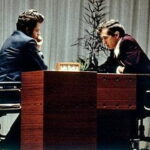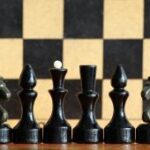There has been talk amongst some chess circles that the royal game of chess has been all but played out. The game has become boring and predictable and played out to a stage where creativity is now limited in its scope.
Even the chess king Bobby Fischer, who is unfortunately now deceased (he died January 2008), advocated just shortly before his death a new variation of chess that he called Fischer random chess.
Bobby Fischer’s aim here I think was to create a type of new chess game in which natural chess creativity, talent and ability could again raise to the level where they were not being overridden by mere rote memorisation of previous games and game positions. This is even more so a very real problem within the opening moves of a chess game.
Bobby perhaps wanted to add back some chance or randominity to the game.
This was never really going to be the case however, as even in his random chess only a certain number of so called random arrangements of the pieces could still exist or occur. He just complicated the game in perhaps what can be described as an ugly way, by removing the innate beauty of the game’s initial time honoured opening set up of the chess pieces at the beginning of a game.
It has been calculated that his new way of playing created another 960 initially possible opening positions.
In this article, I am suggesting that a simple rule change might have been the only answer that was required to achieve Bobby’s overall aim of adding creativity back to the game by helping to remove some of the volumes of analysed opening positions from the heads of the better players.
There have of course been many rule changes made in the past already.
One was the addition to the game in the fourteenth or fifteenth century, when it was allowed for pawns to have the option to move either one or two moves from its original starting position rather than only one. This certainly sped the game up, and added some much needed extra variety to the game.
Another rule was also added at this time called the “en passant” rule, that allowed for one exception to this new rule, and that still allowed for a pawn to be captured when it had moved past an enemy pawn in this new way. The pawn could still be optionally captured by the opposing player with the implementation of this new rule.
The name of this rule comes from the French language, and it means literally “in passing” and which describes rather accurately what is happening here on the chess board.
The chess rules have been altered at so many other different times in its past as well.
The way that a bishop moves for example is only one such change. The bishop’s move was once restricted to only being able to move a maximum of two squares at a time while also still diagonally. It could apparently jump over any piece in front of it on the first square of its move however.
Castling in its modern version was introduced only in the sixteenth century by the Spanish bishop and chess player Ruy Lopez, of whom there is also a famous chess opening named after.
The fifty move rule has been in existence for centuries as well, but it was revised in the twentieth century to allow for complicated endings which required more than the fifty moves so allowed to actually be able to win them. It was argued backwards and forwards about how many moves this should really be extended to.
The advent of computers finally more or less solved this contention and ongoing arguement.
The fifty move rule had floated upwards to allow for nearly one hundred or more moves in some positions, until the powers that be claimed finally that man could not ever match these computers, and in 1992 the strict fifty move rule was again reinstated.
It was claimed at the time that no mortal could ever find on the chess board the exact 59 moves needed for example to win a rook and bishop versus rook endgame. It was just too complex for the human brain to be able work through all of this in his head within the appropriate time frame necessary for a game of chess apparently.
The largest possible length of a legitimate chess game due to these restrictions such as the “fifty move limit” rule, and the other limiting rule known as the “threefold repetition of position” rule has been estimated to be around about 6000 moves long.
The number of possible variations in a game of chess from its initial starting position has even been given a name after the first guy that estimated it.
It is known as the “Shannon” number, after the computer programmer Claude Shannon. The number is ten to the 120th power of itself. Ten to its second power is the number, one hundred. Ten x ten x ten x ten repeatedly written down 120 times is the huge number that they are claiming this to be.
This number above refers to the number of possible games of chess that can be theoretically played.
Other people have revised this estimate down to maybe only ten to the one hundredth power, presumably because the original count included a few illegal positions within it such as occur when two kings are in check at the same time for instance.
The number of possible positions is apparently less than this, and it is roughly about ten to the forty third power only.
My suggestion to make the game of chess even more beautifully complex is simply to enhance or to extend this move of castling as follows.
When castling on either side of the board, the king can move to any square between his own square and the square of the rook that is being used to castle with. The rook then jumps over the king, but it can land positioned on any square from where the king has been placed up until the king’s original position or square. It doesn’t have to necessarily sit right next to the king in this new rule.
The rules about not being allowed to castle, if either the king or the rook has already moved for instance would stay in place, as well as the rule about not being able to move the king through a square that is already under an attack from an opponent’s pieces.
This simple enhancement of this one move of castling would add another whole dimension to the game of chess. Opening strategies and books would all have to be revised and rewritten, and the game of chess would increase again a little in its overall almost infinite possibilities and complexity.
Another Bobby Fischer might be fished out of the woods so to speak, and all because his or her renewed enthusiastic interest was again sparked and regenerated simply from a simple change that was made to enhance the rule of castling in this royal game of chess.





